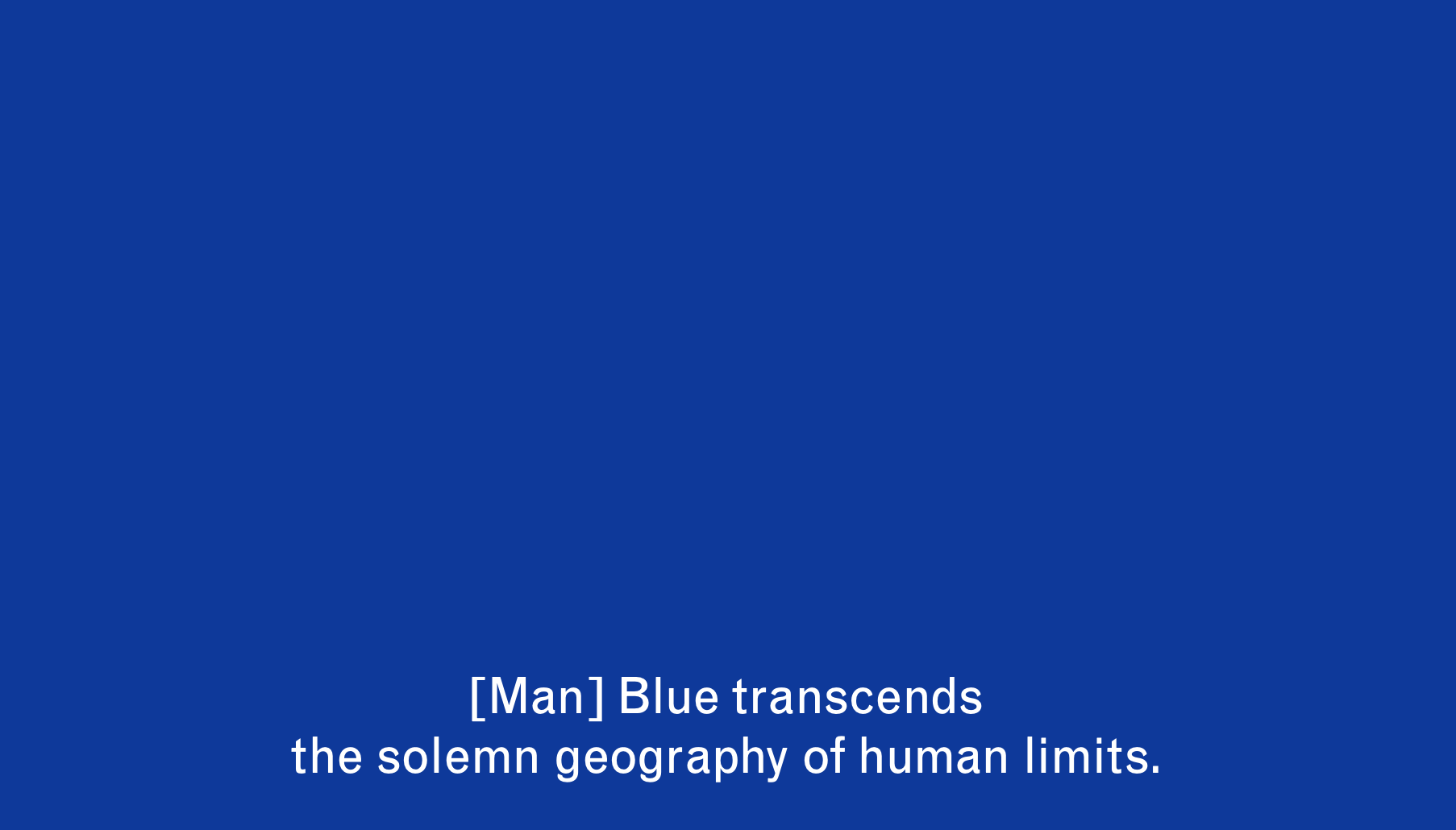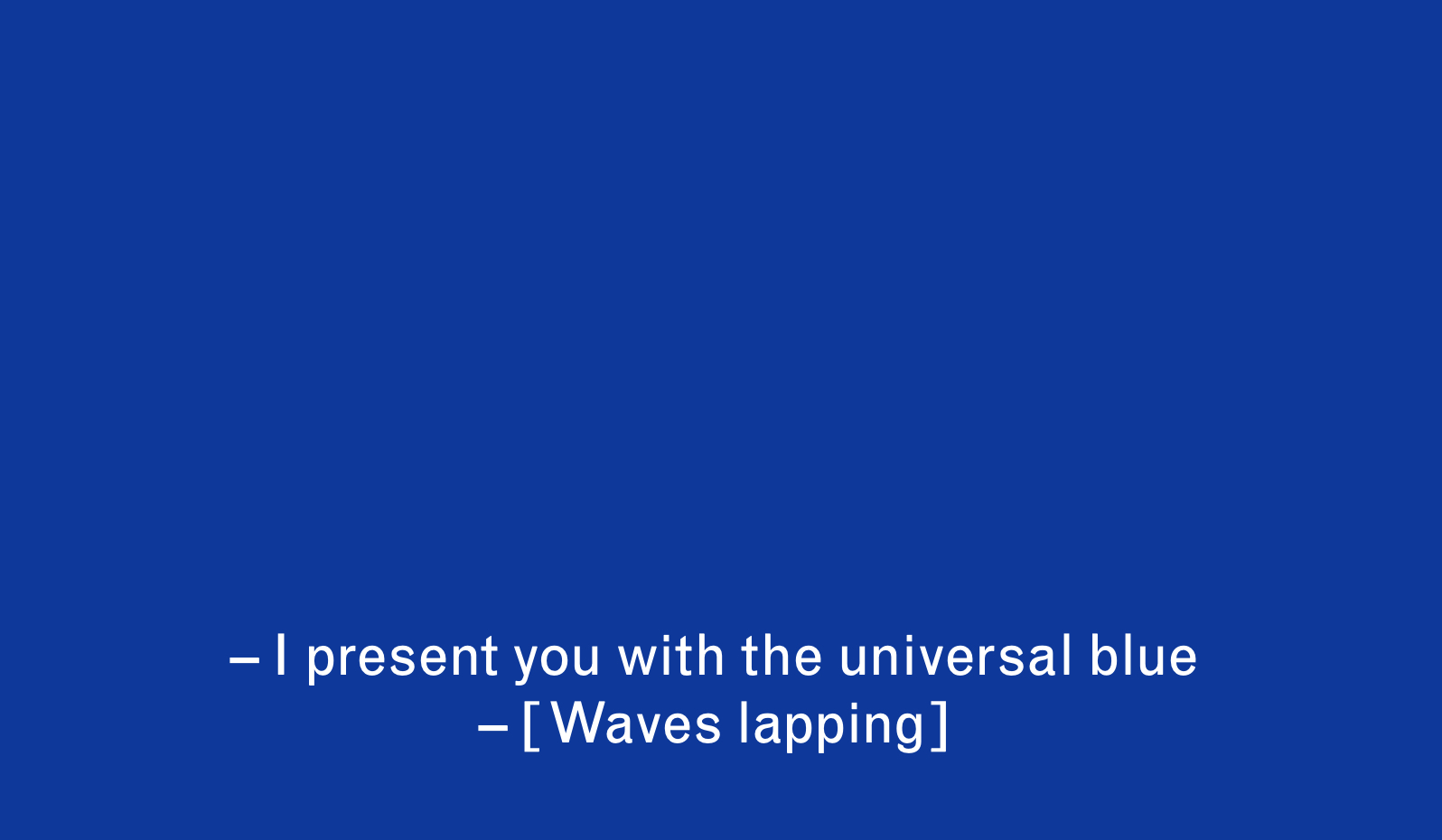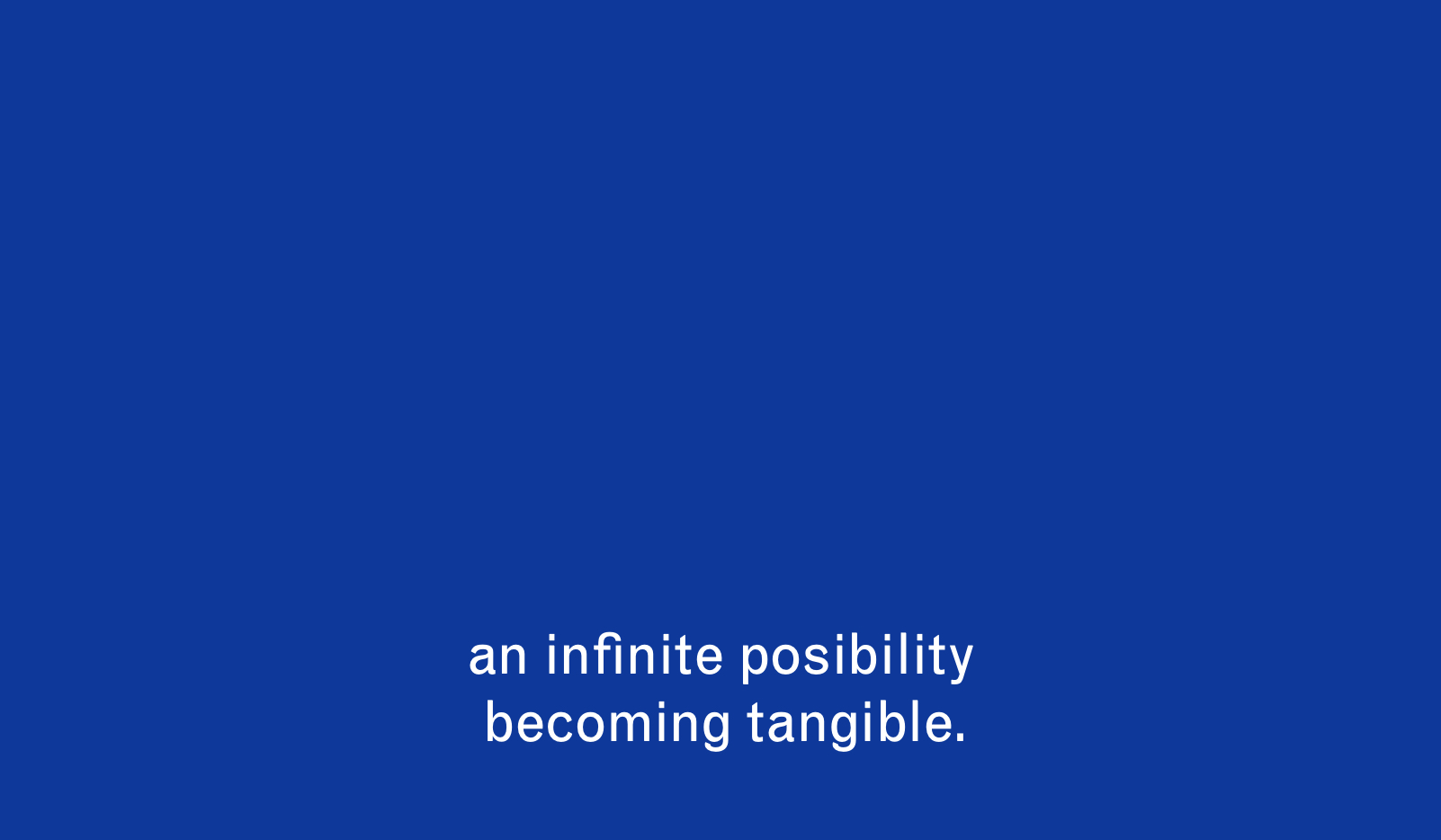Blue Cripistemologies: In and Around Derek Jarman

Derek Jarman, Blue (re-created stills), 1993, video, 35mm film shown as HD video, 79 minutes.
Share:
“I wrote this book in an absence of time. If I have overlooked something you hold precious—write it in the margin.”1
The quote above comes from the book Chroma, one of the last in a suite of works made by the artist Derek Jarman (1942–1994) in navigation of his diagnosis and experience with—and eventual death from—HIV/AIDS. The films, books, and paintings he made during that period remain stark and daring testaments to the function of art during a time of crisis. As a result, Jarman’s life and work have become an indelible part of queer history. His contributions to art and cinema, and his influence on subsequent generations of cultural practitioners, cannot be overstated. Since his death, Jarman’s life and work have become codified by the AIDS crisis2 and used to substantiate the prevailing narrative around art made in response to HIV/AIDS, one that centers and mythologizes the white male gay experience.
Derek Jarman, Blue (re-created stills), 1993, video, 35mm film shown as HD video, 79 minutes.
Derek Jarman, Blue (re-created stills), 1993, video, 35mm film shown as HD video, 79 minutes.
In late 2019, Protest!, a major career-spanning retrospective of Jarman’s work—marking the 25th anniversary of his death—opened at the Irish Museum of Modern Art in Dublin, with satellite projects at Void in Derry and John Hansard Gallery in Southampton. The exhibition, which was then set to travel to the Manchester Art Gallery in April 2020, and then to Yale Center for British Art in 2022, was interrupted by the Covid-19 pandemic. More than a year later, the virus continues to devastate, with the global death toll near 3 million.3 The Covid-19 crisis accelerated calls for art institutions to address social and political inequities. But many major institutions’ responses—serving up massive layoffs4 and exhibition cancelations5 while continuing opportunistic and problematic acquisition practices6 and empty gestures of solidarity7—underscored a need to re-evaluate and re-imagine the relationships among artists, their art, and the institutions that control its dissemination.
In his book The Reorder of Things, Roderick Ferguson interrogates the ways that minority difference has been institutionalized in the academy. Ferguson outlines ways the academy “substitute[s] redistribution for representation, indeed encouraging us to forget how radical movements promoted the inseparability of the two.”8 He argues that institutions operate as “space[s] of consensus” and “disqualify minority difference and minority culture as potential sites of dissensus with the potential to create fissures and to make room for the inadmissible.”9 By “extending Foucault’s emphasis on the productive—and not simply the repressive—capacities of power,”10 Ferguson provides us with a means through which to understand how art museums consolidate their power/influence as cultural institutions “through a revision of the canon”11—the way they transform messy, complicated, and challenging works into polite art12 by deploying reductive and pacifying historical narratives that betray the impetus of the work and restrict its potential value in the present. If our traditional exhibition and curatorial modes remain unable or unwilling to address complexities and complications within works of art, to bring those works into the present moment and allow for critical inquiry, then those modes need to be imagined differently.
Derek Jarman, Blue (re-created stills), 1993, video, 35mm film shown as HD video, 79 minutes.
This critique calls for the development of transgressive strategies that allow us to retrieve, revive, and ultimately reassess work that has become mired in art myth and fraudulent provenance. Jarman’s work, like that of many others who explored HIV/AIDS, continues to be narrativized in a way that limits our understanding of the subject matter to historical document—AIDS as retro, AIDS as over, AIDS as hermetically sealed in the annals of white male gay history. The canonical mode of the Jarman retrospective seems incapable of addressing AIDS as an intersectional crisis and often sublimates the causal relationships and disinformation that activists fought to debunk. This mode operates in service of a clean and reductive narrative, telling the story of something that never really was. This narrative often stands in the way of structural or systemic analysis that might complicate or threaten a work’s potential value, should it be revisited critically. Our current moment requires us to refresh and re-evaluate conversations that were central to the AIDS epidemic—primarily those surrounding causal relationships, care networks, and compulsory able-bodiedness. To chronologize or compartmentalize Jarman’s work is to betray its most valuable and enduring qualities. His later films embrace complexity, complication, and contradiction, echoing the ways that contemporary Crip discourse has foregrounded an intersectional analysis of a sick/disabled experience. Per his invitation to “write [something he overlooked] in the margin,”13 I revisit Jarman’s last film, Blue (1993), to explore its enduring value as a foundational Crip work, as well as to critically engage the limitations of the narrative the work has been used to substantiate.
“Blue transcends the solemn geography of human limits.”14
Blue, more than any other Jarman work, is founded upon the oft-irreconcilable complications of embodiment. In both form and content Blue exists in a multiplicity that might best be understood and valued through its relationship to contemporary Crip/Disability discourse. Through the use of a cripistemological15 framework, we might begin to peel back the tired and impeding interpretations of Blue as an autobiographical film, one that functions as an anti-portrait of a person with HIV/AIDS and, instead, explore its enduring value as a Crip work. Blue problematizes the delimitations of identity that prevent coalition and discourage intersectional critique.
Derek Jarman, Blue (re-created stills), 1993, video, 35mm film shown as HD video, 79 minutes.
Blue is a multifaceted work that beautifully reconciles visual, aural, and textual components to create an expansive and affective experience of a Queer/Crip interiority. Blue resists the simplistic and reductive characterizations that claim it is a film with “no image,”16 with “nothing to look at”17 but a “single static shot”18 of International Klein Blue that you “watch … for the film’s 79 minutes.”19These characterizations immediately betray themselves when they attempt to describe the film’s alleged simplicity as an “absorbing”20 experience that “pulses, shimmies, [and] reveals elusive shapes and dimensions.”21 These descriptive ruptures reveal the degree to which art and cinema have foreclosed upon our understanding of visuality under the guise of expanding (read mastering) it. They trouble our desire for binary reductions and expose the limitations of our vocabulary—or unwillingness to develop it—to respond to something more expansive or complex. Much of the writing about Blue positions its formal and conceptual exploration of sight exclusively in terms of loss.22 Leaning heavily upon the autobiography of Derek Jarman the individual, these readings drift away from the work itself and rely upon the clichés of pity/inspiration so often deployed in attempts to contain or pacify a Crip/Disabled experience. It is accurate to state that the formal choices in Blue were shaped in response to Jarman’s experience with the cytomegalovirus and the effect it had on his sight.23 However, interpretations that constrain the experience by narrativizing it as AIDS-related blindness seem to say: It’s so sad that this great filmmaker lost his vision because of awful AIDS, but isn’t it brave and beautiful that he persevered in spite of such a horrible and grotesque condition to create this film for us. It is sad he lost his battle with AIDS, but at least we have this film as his uplifting final statement. Instead, we should understand Blue as a site wherein Jarman developed a visuality that is expansive and transcendent, as well as deeply embodied and imperfect, a “fragment of an immense work without limit.”24
Blue was originally released in film, television, radio, CD, and book formats. Despite being referred to as a feature film, Blue never existed exclusively in one medium. Its premiere was simulcast on Channel 4 and Radio 3 (UK television and radio respectively), and screened theatrically at the MGM Panton Street theater in London.25 The formats in which Blue existed before its formal release, and the various modes in which it was made available simultaneously, decentralize its content and resist simplistic interpretations. Blue provides multiple points of access that are not indexed by a “primary” or “intended” format through which to experience the work. Modes that would typically be considered supplemental in a film-based interpretation—where text is “script,” and audio is “soundtrack”—actually reveal how Blue deals with notions of sensory loss. For example, the writing for/text of Blue can be found across numerous publications, including Jarman’s memoirs and journals, the booklet that accompanies the CD version, and as a chapter in Jarman’s last book, Chroma. These text-based formats, which predate the film version, disrupt our understanding of a script as text that needs to be vocalized or externalized to be fully instantiated. This multiplicity draws our attention toward the text’s function as a space of Queer or Crip interiority. Blue’s formal variants allow us to reflect upon the ways that art leverages a series of ability-based assumptions (read requirements) to construct an interpretive space for the work to be parsed or understood. Blue complicates singularly formatted work and reveals the degree to which that singularity relies upon willful inaccessibility.
Derek Jarman, Blue (re-created stills), 1993, video, 35mm film shown as HD video, 79 minutes.
Jarman’s use of formal multiplicity provides a basis or ground upon which Blue uses shifting narrative modes in service of a flexible temporal structure—one that echoes and expands upon notions of Crip time. In her essay “Six Ways of Looking at Crip Time,” Ellen Samuels explores how time moves in and around the Crip/Disabled body, and she examines the way Crip time functions “not only as a form of liberation, but also as a site of loss and alienation”26—Crip time as time travel, as grief time, as broken time. Blue mobilizes the onerous citizenship27 of illness to create the enveloping experience of being communicated to/at/with/near/through. Its temporality shares a kinship with Samuels’ notion as it is characterized by multiple, often contradictory, sensations of time that exist in tension between the expansive and transcendent past and future, and the acute and urgent present.28 Blue moves with fluidity between lyrical, diaristic, philosophical, and dialogic modes—often allowing them to overlap. Over the course of a few moments, Jarman shifts between poetic and ethereal verse, remembrances of dead lovers and friends, sensory accounts of eye examinations, the tedium and depersonalization of hospital waiting rooms, and musings on the deterioration of sight. Through all this, Jarman creates a space wherein those experiences are allowed to co-define, echoing Samuels’ observation of the way that “disability and illness have the power to extract us from linear progressive time … and cast us into a wormhole of backward and forward … tedious intervals and abrupt endings.”29Through this shifting, Blue becomes a site that situates itself at the intersection between Queer and Crip potentialities.30 It forgoes delineation between the empirical and the theoretical, and instead allows them to complicate each other within the space of the work. Blue generates a radical possibility through that complication. In the interstitial space between these critical projects, we are better able to understand notions of interdependence and have the opportunity to re-imagine networks of care and coalition in ways that embrace complication and complexity. Blue develops a critically Queer/Crip presence that allows us to move in, around, and beyond delimiting identarian narratives and toward expansive and generative understandings of embodiment.
“For Blue there are no boundaries.”31
***
“I want to share this emptiness with you. Not fill the silence with false notes or put tracks through the void. I want to share this wilderness of failure. The others have built you a highway—fast lanes in both directions. I offer you a journey without direction, uncertainty and no sweet conclusion. When the light faded, I went in search of myself. There were many paths and many destinations.”32
Christopher Robert Jones is an artist and writer based in Illinois. Their research revolves around the “failure” or “malfunctioning” of the body and how those experiences are situated at points of intersection between Queer and Crip discourses. Jones received BA degrees in art studio and technocultural studies from UC Davis and an MFA from the University of Illinois Urbana-Champaign, where they are currently a specialized faculty in new media.
References
| ↑1 | Derek Jarman, Chroma, (London: Vintage Classics, 1995), 42. |
|---|---|
| ↑2 | I would like to note here how the differentiation between an understanding of the “AIDS crisis” as something that happened versus something that is continuing to happen (see Gregg Bordowitz’s The AIDS Crisis Is Still Beginning) reveals the ways in which that point of view is entrenched in a white-supremacist ableist capitalist patriarchal system (to borrow/modify bell hooks’ term). |
| ↑3 | World Health Organization, “WHO Coronavirus (Covid-19) Dashboard,” World Health Organization, online. |
| ↑4 | “Tate To Slash More Than 300 Commercial Jobs,” ArtForum, August 12, 2020, online. |
| ↑5 | Sophie Haigney, “When the Virus Came, Some Museum Curators Lost Years of Work,” New York Times, May 6, 2020, online. |
| ↑6 | Helen Holmes, “Whitney Museum Slammed for Acquiring Black Artists’ Work Way Under Market Value,” Observer, August 25, 2020, online. |
| ↑7 | Hakim Bishara, “SFMoMA Accused of Censoring Black Voices After Removing Comment by Former Employee,” Hyperallergic, June 2, 2020, online. |
| ↑8 | Roderick A. Ferguson, “Affirmative Actions of Power,” Introduction, in The Reorder of Things: The University and Its Pedagogies of Minority Difference (Minneapolis, MN: University of Minnesota Press, 2012), 8. |
| ↑9 | Ibid., 18. |
| ↑10 | Ibid., 8. |
| ↑11 | Ibid., 6. |
| ↑12 | To borrow the term Irena Haiduk develops in her manifesto on polite art, Bon Ton Mais Non. |
| ↑13 | Derek Jarman, Chroma (London: Vintage Classics, 1995), 42. |
| ↑14 | Blue, DVD (United Kingdom: Basilisk Communications, 1993). |
| ↑15 | Here I refer to the term as it was developed in the “Proliferating Cripistemologies” virtual roundtable led by Robert McRuer and Merri Lisa Johnson in 2014 to explore the “potentialities … of structurally placing crip(s) at the beginning or center of the production of knowledge,” Robert McRuer and Merri Lisa Johnson, “Proliferating Cripistemologies: A Virtual Roundtable,” Journal of Literary & Cultural Disability Studies, 8, no. 2 (2014), 149–169 |
| ↑16 | Bianca Stoppani, “Protest!: Derek Jarman at IMMA—Ireland Museum of Modern Art, Dublin,” Mousse Magazine, online. |
| ↑17 | Jonathan Romney, “Blue,” in Derek Jarman: Glitterbox (New York: Zeitgeist Films, n.d.). |
| ↑18 | Andrew Wilson, “Blue,” Collection Notes (Tate, November 2013), online. |
| ↑19, ↑21 | Romney, 2. |
| ↑20 | Stoppani, 1. |
| ↑22 | Emphasis added to indicate the ableism inherent in that distinction. |
| ↑23 | Tim Ellis, “Blindness and Insight,” in Derek Jarman’s Angelic Conversations (Minneapolis, MN: University of Minnesota Press, 2009), 235. |
| ↑24 | Tony Peake, essay in Derek Jarman: A Biography (London: Little, Brown, 1999), 515. |
| ↑25, ↑29 | Ibid. |
| ↑26 | Ellen Samuels, “Six Ways of Looking at Crip Time,” Disability Studies Quarterly, Sustenance and Sustainability, 37, no. 3 (2017). |
| ↑27 | To borrow the term Susan Sontag uses at the outset of her book Illness as Metaphor (1978). |
| ↑28 | It is worth noting that all of Jarman’s film projects bring the past (historical narrative) to bear on his present through the use of queer historical fantasy—primarily to excavate a critically queer (to borrow Judith Butler’s term) history that has been straight-washed. |
| ↑30 | Here we might imagine an imbrication of Ellen Samuels’ Crip time as time travel and José Esteban Muñoz’s queer futurity “as an ideality that can be distilled from the past and used to imagine a future.” |
| ↑31 | Derek Jarman, “Blue: A Film By Derek Jarman,” Mute Records, CDSTUMM 49, 1993, compact disk. |
| ↑32 | Derek Jarman, The Garden, DVD (United Kingdom: Basilisk Communications, 1990). |




